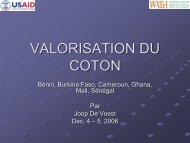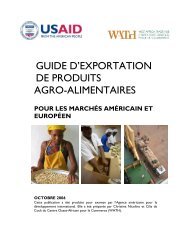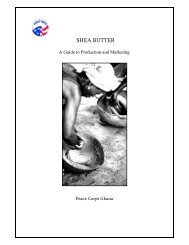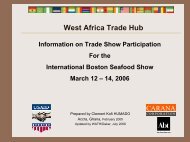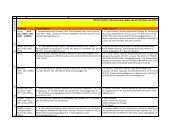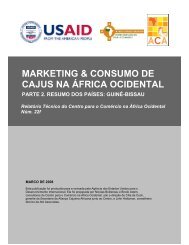A Brief Introduction to Textile Processing - AGOA Export Toolkit
A Brief Introduction to Textile Processing - AGOA Export Toolkit
A Brief Introduction to Textile Processing - AGOA Export Toolkit
Create successful ePaper yourself
Turn your PDF publications into a flip-book with our unique Google optimized e-Paper software.
Further processing.<br />
Fully constructed garments may be “further processed,” by dyeing, chemical treatment, embroidery, or<br />
other mechanical or chemical treatments. The ultimate goal at each step is <strong>to</strong> produce an end –<br />
product that meets the needs of the target consumer.<br />
Chemical treatments. With the popularity of the faded or distressed look in garments, particularly<br />
denim garments such as jeans, many garments are being further processed with enzyme, acid, or<br />
other chemical treatments. These treatments fade the color as if the garments had been laundered<br />
repeatedly over a long period of time. Although such treatments weaken the fabric (hence garments)<br />
somewhat (sometime substantially), fashion trends have made the processes popular. For some<br />
garments such as rainwear, water repellant finishes may be applied or reapplied <strong>to</strong> assembled<br />
garments. In the case of high performance rainwear, and some types of activewear for which water<br />
repellency is important, sealants may be applied <strong>to</strong> seams after garments are assembled.<br />
Physical treatments. Similar distressed looks, and a softer feel can also be achieved at the garment<br />
stage using “s<strong>to</strong>ne washing” or “sand washing” methods.<br />
Embroidery. Embroidery is commonly used on apparel for decorating or embellishing the garment.<br />
For greatest quality and efficiency, many garment manufacturers invest in highly computerized<br />
embroidery equipment that replicates a design over and over again with precision and speed at low<br />
cost.<br />
Quality assurance / quality control<br />
Quality assurance and quality control have attracted much attention in recent years. While formerly<br />
only quality control was emphasized, that is inspecting products and rejecting those that did not meet<br />
quality standards, in the past thirty years or so, emphasis has shifted <strong>to</strong> preventing defects (or assuring<br />
quality) rather than simply controlling for quality after defects may have been introduced. Emphasis<br />
was also placed on taking steps throughout the manufacturing process <strong>to</strong> assure high quality, rather<br />
than waiting until the end after which many resources (raw materials, labor, energy) have been<br />
expended.<br />
Quality assurance. QA, as it is often called, incorporates engineering quality in<strong>to</strong> the garment from<br />
the earliest stages: selecting the proper raw materials, selecting the best construction techniques,<br />
calibrating and maintaining equipment properly so that stitching, pressing, and finishing is correct,<br />
and so forth. QA begins with the product design and specification, carries through raw materials<br />
sourcing and receipt, and ends only after finished garments have been shipped, and follow – up<br />
correspondence has been completed.<br />
Because the quality of raw materials and findings is critical <strong>to</strong> the quality of the finished garment,<br />
apparel manufacturers should carefully select raw yarns, fabrics, threads, but<strong>to</strong>ns, zippers, and other<br />
findings from reliable suppliers, should require that suppliers conduct or guarantee certain specific<br />
levels of colorfastness, strength, shrinkage, and should conduct some testing of raw materials and<br />
findings themselves. Any that do not meet agreed upon standards should be returned immediately <strong>to</strong><br />
the supplier for replacement or refund.<br />
Common quality testing in the apparel industry includes:<br />
• Fabric strength<br />
• Colorfastness<br />
• Shrinkage<br />
Prepared by Margaret Bishop and Brent Smith for the West Africa Trade Hub 8/04 17



